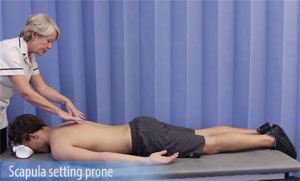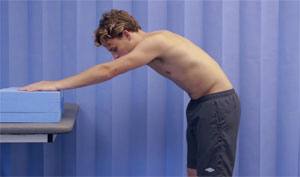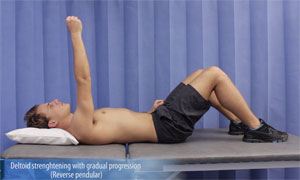Physiotherapy Videos
Video Examples of Physioteraphy Exercises
Please be aware that general anesthesia or sedation will temporarily affect your co-ordination and reasoning skills, so you must not drive, drink alcohol, operate machinery or sign legal documents for 24 hours afterwards. If you're in any doubt about driving after surgery, contact your motor insurer so that you're aware of their recommendations, and always follow your surgeon’s advice.
While in the post operative phase follow-up consultations are usually booked at: 3 Weeks, 3 Months, 6 Months and if needed 1 year after surgery.
This is a series of physiotherapy exercises that you will find helpful and that your Consultant and Physiotherapist may advise you to follow as part of your treatment.
IT IS IMPORTANT THAT YOU ONLY DO EXERCISES APPROVED AND GIVEN TO YOU BY YOUR CONSULTANT OR PHYSIOTHERAPIST.
- 1 Posture
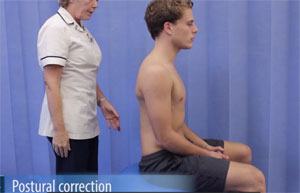
Stretch your head and spine to the ceiling. Tighten the lower trap muscles. Maintain the posture and gently bounce.
Set the shoulder blades down and in by engaging the lower trapezius muscles, highlighted by the therapist.
To progress, lift the arms and hold, adding arm rotation in the final stage.
Set the shoulder blades down and in by engaging the lower trapezius muscles, highlighted by the therapist.
To progress lift the arms and hold, adding arm rotation in the final stage.
Place hands directly under the shoulders and your knees under your hips. Keep your chin in, and back straight throughout the exercises. Initially transfer your weight from side to side and then progress to lifting one arm, or leg or both in combination from the floor.
Keeping the body vertical, set the scapula and slowly move towards the ball, pause, and then return, ensuring control.
- 3 Sling
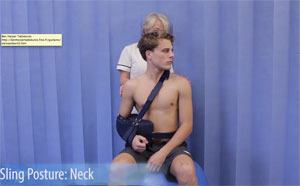
Sit in a good posture lifting your head towards the ceiling. Rotate your head to the left and right. You may also shrug your shoulders and perform small circles.
Stretch your hand out and make a fist. Move your wrist forwards and backwards. Rotate your forearm to the ceiling and down, assisting if required.
Release your forearm from the sling and allow your elbow to straighten with the hand facing forwards. Assist if required and then repeat.
Keeping your shoulders as relaxed as possible, place a light weight in your hand allow the arm to gently swing . This is a passive exercise.
Place hands on a surface level with your hips, slowly walk your feet back until you feel your shoulder stretch. Your body weight should remain over your feet, not through the shoulder
Grasp your wrist, taking the affected arm over your head. Hold at resistance and return. Keep the affected arm as relaxed as possible throughout the movement.
Take your arm by the wrist, assisting your affected arm place your hands behind your head. Allow your elbows to relax out, as if sunbathing, hold and then return. Ensure you assist the affected arm when returning to the abdomen.
To progress inter-lock the fingers to assist the hands to reach the behind the head position.
With the stick on your chest, straighten your arms and then slowly take your arms over your head. When finished return the stick to your chest.
Sitting in good posture, use the pulley to elevate the arm overhead to resistance, hold and repeat.
Keeping your body straight slowly push your arm out to the side. Ensure you do not raise your shoulder to your ear, which is known as hitching.
While pushing the arm into external rotation, gently squeeze a towel against the side of your body, isolating the movement. Hold the stretch for 5 seconds.
Holding a stick behind you, gently pull the arm towards the centre of your spine, hold and then relax.
All the stretching exercises should be repeated 2-3 times in the same session, with 2-3 session per day holding the position for 25-30 seconds avoiding any pain during their execution.
- 5 Selfstretching Dr. Liotard
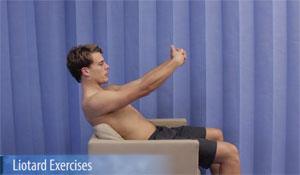
Leaning back in the chair, interlock your fingers and take your arms over your head, and return to your starting position. Take your hands behind your head and allow your elbows to stretch out to the side, return. Finally take your arms over head rotating the palms to face the ceiling during the movement and then return.
Take your arm to 90 degrees, allow the forearm to drop slightly and then take the arm across the body to resistance
All the stretching exercises should be repeated 2-3 times in the same session, with 2-3 session per day holding the position for 25-30 seconds avoiding any pain during their execution.
Lye on your back, grasp your wrist with the other hand to help it to the vertical position and hold. Return with assistance if required. When you can lift the arm independently perform a small arc movement, ensuring a continuous fluid movement in line with the body. Continue until fatigue.
To progress increase the size of the arc until controlled full range of movement is achieved.
For the next stage add a small weight to the exercise increasing the arc as able. Continue for 5 minutes or until fatigue.
Finally complete the exercise in a propped up position, increasing the arc size and adding a weight as appropriate.
- 7 Strenghtening
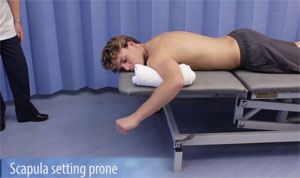
Support the upper arm, keeping the elbow at 90 degrees rotate the forearm up wards. This can be progressed, performing the exercise without the towel support.
Keeping you elbow at 90 degrees rotate your forearm down towards your lap and return, rotating at the shoulder. This can be progressed by placing the elbow on a book.
Set your shoulder blades, keeping the elbows tucked in. Slowly pull the band apart without rotating the forearm and return to the start position.
Slowly pull the band up and outwards, rotating the arm through the movement, as if drawing a sword.
Lift the arm up and across your body rotating your arm through the movement and slowly return.
Pull the towel apart, lift to your chest and keep pulling as you lift your arms over your head. Remember to keep the arms near your body while you are elevating them (need to be added). Return to the start position and repeat.
To progress pull the towel apart at your hips and slowly move your arms up and over your head. Keep the elbows straight throughout the movement.
Press the back of your hand into the wall as you elevate your arm. This movement can be combined with a step, leading with the leg opposite to the moving shoulder. When it becomes easy, gradually rotate your body away from the wall 30/60/90 degrees to reach the abduction position.
- 9 Proprioception
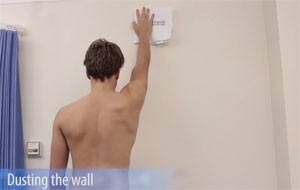
Set your shoulder blades and slowly elevate the arm, dusting the wall. Pause and control the movement down, and repeat.
Move the swiss ball around the wall using both hands. Add a step to increase difficulty. Finally complete the exercises with only one arm.
- 10 Advanced Stretching
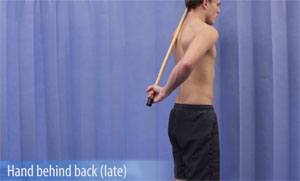
To progress gently pull the arm away from your back, stopping at resistance.
Lye on the effected side, with your arm and elbow at 90 degrees. Gently push the forearm down until you feel resistance, relax and repeat.
Take your arm to 90 degrees, allow the forearm to drop slightly and then take the arm across your body to resistance.
Place your hand in a door way with your elbow at 90 degrees. Fix your elbow against your body with the other hand. Gently rotate your body away from your arm until you feel resistance, hold and repeat.
With your shoulder and elbow at 90 degrees in the door frame, gradually rotate your body stretching your shoulder. Also shown from a posterior view.
All the stretching exercises should be repeated 2-3 times in the same session, with 2-3 session per day holding the position for 25-30 seconds avoiding any pain during their execution.

